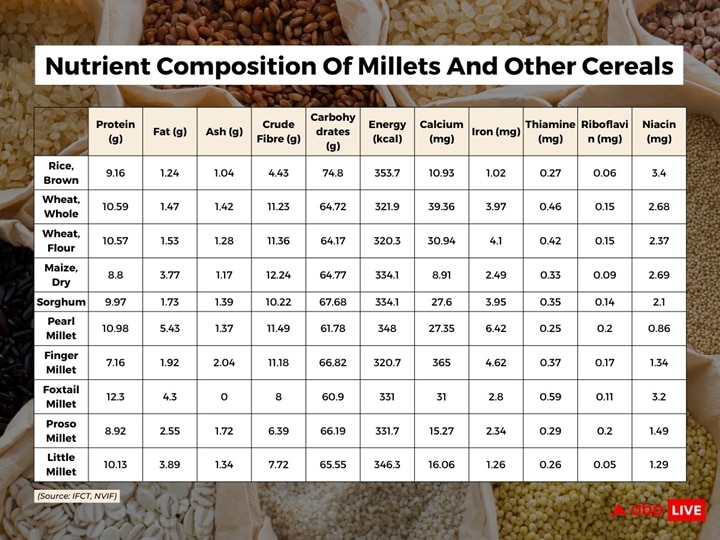Millets Are Great For Your Health, But A Millet-Only Diet Is Not. Experts Say Why
The menu for visiting G20 leaders and delegates will be dominated by innovative millet-based dishes.

Ragi dosa, bajre ki tikki, bajra khichdi, korra millet salad, rajgira poori with aloo ki sabzi — these are among the host of food items made of millets that are now part of the menu at the Parliament canteen. In fact, the menu for visiting G20 leaders and delegates will also be dominated by innovative millet-based dishes.
Called "super grain" due to it being rich in proteins, carbohydrates and fibre, the year 2023 has seen a shift in the discourse in favour of millets after being promoted and popularised by Prime Minister Narendra Modi's government.
While the importance of millets and the health value they add to our diet cannot be ignored, a little care needs to be taken while deciding the quantity of it to be consumed by an individual. Overconsumption of millets could lead to negative consequences too, health experts warn, and say that it cannot be the sole source of nutrition.
Millets Contain Anti-Nutrients In Comparison To Wheat, Rice
According to Dr Varsha Gorey, senior clinical dietician at Apollo Hospitals in Navi Mumbai, while millets are gaining importance as they are good sources of carbohydrates, vitamins and minerals, it is not advisable to eat only millets as they lack certain essential amino acids. "So, millets are not a complete protein," she told ABP Live.

Dr Charu Dua, chief clinical nutritionist at Amrita Hospital, Faridabad, said millets contain relatively elevated levels of anti-nutritional factors in comparison to wheat and rice.
"The anti-nutrients found in millets may include tannins, phytates, oxalates, trypsin and chymotrypsin inhibitors. Among these, enzyme inhibitors and phytic acid are notable examples. Phytic acid, in particular, can hinder nutrient absorption by binding to vital minerals and preventing them from being absorbed by the body," Dr Dua said.
Millets, particularly pearl millet, have a high concentration of oxalates, which can lead to kidney stones, she added.
Swapnali Jambe, nutrition advisor at Fast&Up and training coordinator at FSSA Council, which trains CRPF sportspersons, also cautioned that millets can cause delayed digestion due to their slow digestibility as they are high in fibre. "People with intestinal disorders can have difficulty," Jambe said.
READ | 'Mother Of All Grains': Why You Should Eat Millets, The Superfood In Focus After FM's Budget Speech
Can Thyroid Patients Consume Millets?
Several studies have also found millets to be goitrogenic, which means it might interfere with the iodine absorption in the body.
A study published in National Library Of Medicine revealed that goitre was more widespread in rural villages located in the Darfur Province of Sudan, where up to 74 per cent of dietary energy was obtained from millets, than in an urban area where millets contributed only 37 per cent of calories.
"Some of the phenolic compounds present in millets can disrupt numerous enzymatic systems in the human body. In particular, they can interfere with the systems responsible for regulating thyroid hormone synthesis, potentially leading to impairment," said Dr Charu Dua.
"Such interference can result in the formation of goitre, which is characterised by the enlargement of the thyroid gland, leading to swelling in the neck or larynx," she added.
However, this does not mean that people with thyroid dysfunction cannot consume millets at all.
"People with thyroid dysfunction can certainly use millets like ragi, amaranth, little millets but need to refrain from pearl millet and sorghum as these contain anti-thyroid components," said Dr Zubeda Tumbi, clinical nutritionist and dietitian, Healthwatch Nutrition Clinic.
So, How Much Millets Should Be Consumed In Daily Life?
The past year has seen fitness and health enthusiasts starting to realise the benefits of millets, and the trend of going gluten-free has weaned people off staples like rice and wheat.
Dr C Tara Satyavathi, Director, Indian Institute of Millet Research (IIMR), said it is not recommended that one totally removes rice or wheat from their diet.
With the United Nations declaring 2023 as the International Year Of Millets, she said, there has been a 30 per cent increase in millet consumption in three months.
"The ICMR's National Institute of Nutrition has recommended that those with a sedentary lifestyle can (daily) consume 270 gms of cereals (including millets). Thus, one can consume around 90 gms of cooked millet per day as part of a balanced diet," Dr Sathyavathi of IIMR, which the Centre said would be supported as Centre of Excellence, told ABP Live.
She said there are scientific reports showing that there is a positive impact of millets on health.
"There are many publications coming out from ICMR-based institutes that those who are being fed with millets-based diet, compared with the control group, have seen an increase in haemoglobin levels also. Also, for diabetic people, it has been found that the HbA1c level (sugar level) has come down after a couple of months of being fed with millets," said Dr Satyavathi, who has also worked as principal scientist at the Indian Agricultural Research Institute.
Important To Lower Millets' Anti-Nutrient Content
Experts said it is important to unbind the anti-nutrients to derive maximum health benefits from millets.
Dr Zubeda Tumbi, who also consults on Practo, said simple processing steps such as "decortication, germination and fermentation" when applied to millets "significantly improves both starch and protein digestibility".
"To unbind the anti-nutrients, soak them overnight or 8-10 hours in slightly warm water. Before cooking, rinse the soaked millets. Cook them in excess water as some millets absorb too much water because of fibre content," added Dr Dua of Amrita Hospital.
Check out below Health Tools-
Calculate Your Body Mass Index ( BMI )
Calculate The Age Through Age Calculator
Related Video
Punjab News: AAP Leader Shot Dead During Wedding in Amritsar





































